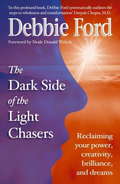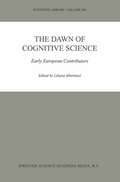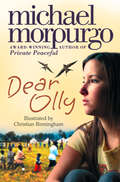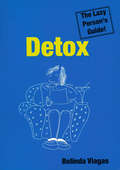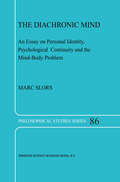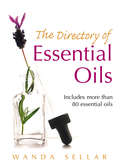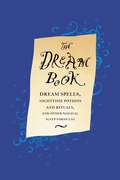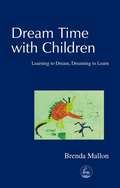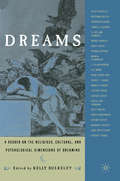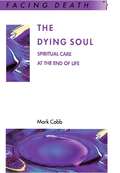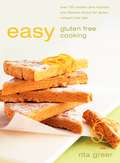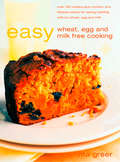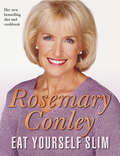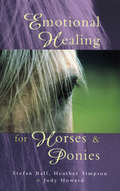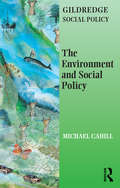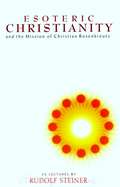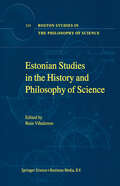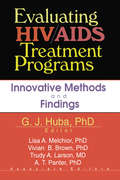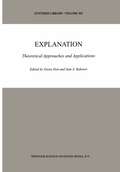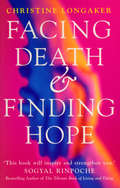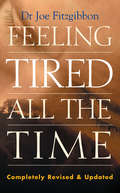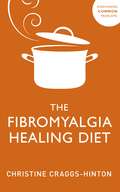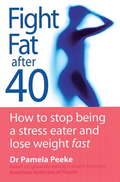- Table View
- List View
Dark Side of the Light Chasers: Reclaiming your power, creativity, brilliance, and dreams
by Debbie FordIn this enlightening guide, Debbie Ford explains that the dark side of our personality should not be hidden. By denying our dark side, we reject these aspects of our true natures rather than giving ourselves the freedom to live authentically. Here she shows that it is possible to acknowledge and accept our so-called weaknesses, proving that these qualities may be important, hidden strengths. For example, perhaps some 'selfishness' can save us from exhaustion and resentment. Full of illuminating stories and practical exercises, Debbie Ford shows us how to reconcile our darker impulses and find the gifts they offer. Your life will be transformed when you unconceal, own, and embrace your shadow.
The Dawn of Cognitive Science: Early European Contributors (Synthese Library #295)
by LilianaAlbertazziCurrent debate in cognitive science, from robotics to analysis of vision, deals with problems like the perception of form, the structure and formation of mental images and their modelling, the ecological development of artificial intelligence, and cognitive analysis of natural language. It focuses in particular on the presence of a hierarchy of intellectual constructions in different formats of representation. These diverse approaches, which share a common assumption of the inner nature of representation, call for a new epistemology - even a new psychophysics - based on a theory of reference which is intrinsically cognitive. As a contribution to contemporary research, the reading presents the core of theories developed in Central Europe between the late nineteenth and early twentieth centuries by philosophers, physicists, psychologists and semanticists who shared a dynamic approach and a pronounced concern with problems of interaction and dependence. These theories offer innovative solutions to some of the epistemological and philosophical problems currently at the centre of debate, like part-whole, theory of relations, and conceptual and linguistic categorization.
Dear Olly
by Michael MorpurgoDiscover the beautiful stories of Michael Morpurgo, author of Warhorse and the nation’s favourite storyteller A moving story of a brother, a sister and a swallow, and how all are in some way victims of the horrors of landmines.
Detox: The Simplest Way to a Fitter Body, a Clearer Mind and Higher Spirits (The\lazy Person's Guide! Ser.)
by Belinda ViagasBased on the simple principle of detoxification as a means of cleansing your system, the dynamic, natural techniques in Detox: The Lazy Person’s Guide! will give you a fitter body, a clearer mind and higher spirits.Author Belinda Viagas offers the simplest of rules to guide your detox, tailor-made to your individual needs, telling you what to eat, how to prepare it, and what to avoid. A series of easy exercises will further boost your circulation and stimulate your immune system.The Lazy Person’s Guide! is a series of popular, cheerful yet thoroughly grounded, practical and authoritative books on various health issues and conditions. Other titles in the series include Beating Overeating, Exercise, Improving Your Memory, Midlife, Quitting Smoking, Self-esteem and Stress. Other books by Belinda Viagas include the Detox Diet Book, Natural Healthcare for Women and The Pocket A–Z of Natural Healthcare.Detox: A Lazy Person’s Guide!: Table of ContentsIntroductionWhy Detox?Food as MedicineThe Effects of StressDiet and StressThe BenefitsHow to DetoxWorking with FoodsAdding HerbsFollowing the SeasonsGetting StartedTargeting Your DetoxPreparation mealsYour Detox PlansOne-Day DetoxTwo-Day DetoxFour-Day DetoxWeek-long DetoxThe Original Detox DietRecipesSalad DressingsSaladsSoupsSweet ThingsCooked MealsBack-up InformationCleansing TechniquesBrushing WellDry Skin BrushingMassageExerciseHydrotherapyClearing Your MindAffirmationsVisualisationsMeditationNo Time to DetoxDetox Your LifeA Personal AuditPractical StepsNew ThingsResources and Reading GuideFurther ReadingFinding a PractitionerContacts
The Diachronic Mind: An Essay on Personal Identity, Psychological Continuity and the Mind-Body Problem (Philosophical Studies Series #86)
by M.V. Slorsvii 1 ~OOUCTIONANOOVERVlliW 1 2 SEITING THE STAGE: PERSONAL IDENTITY ANO THE MErAPHYSICS OFMIND 1. Introduction 6 2. The Problem of Personal Identity over Time 7 3. The Psychological Criterion of Personal Identity over Time 12 4. The Neo-Lockean Psychological Criterion of Personal Identity 16 5. The Circularity Objection 19 6. Problems of Logical Form 21 7. The Lack of a Third-Person Criterion for Reidentification 23 8. The Unity of the Mental Bundle 25 9. The Individuation ofPersons 26 10. The Neo-Lockean Criterion and Physicalism: a 'Natural' Alliance 28 11. One 'Solution' to Five Problems 35 3 PARFIT'S REDUcrIO OF A SUBSTRATUM-ORIENTEO CONCEPfION OF PSYCHOLOGICAL CONTINUlTY 43 1. Introduction 2. Relation R 45 51 3. Relation R and the Neo-Lockian Paradigm 4. Psychological Atomism 56 61 5. The Central Place of Q-Memory in the Neo-Lockean Paradigm 64 6. The Trouble with Q-memory 74 7. Contents and Contexts. The Other Four Problems 79 8. Conclusions 4 A CON1ENT-ORIENTEO CONCEPTION OF PSYCHOLOGICAL CONTINUITY 82 1. Introduction 83 2. Two Kinds of Psychological Continuity 91 3. Levels of N-Continuity 93 4. The Unity of N-Continuous Sequences. The Role of the Body 105 5. N-Continuity and Psychological Connectedness 109 6. Summary vi 5 A PSYCHOLOGICAL CRI1ERION OF PERSONAL IDENTITY: THE AVE PROBLEMS REVISITED 1. Introduction 111 2. Circularity, Q-Memory, and N-Continuity 112 119 3. Narrativity and Logical Form 127 4. Third-Person Criteria of Reidentification: The Role of the Body 5.
The Directory of Essential Oils: Includes More Than 80 Essential Oils
by Wanda SellarThis is a practical directory of over 80 essential oils, covering many unusual oils as well as those that are in popular use. The oils are extensively categorised, with each entry offering valuable information at a glance. Helpful descriptions are given of the oils' aromas, their chemical constituents and their effects on the mind and body. Fascinating information is also included about the oils' histories, their extraction methods, and the myths and legends associated with them. There is also useful guidance on the effects of essential oils on the skin and their use in blends and treatments.
The Dream Book: Dream Spells, Nighttime Potions and Rituals, and Other Magical Sleep Formulas
by Gillian KempFrom the author of the popular Fortune-Telling Book comes a beautifully illustrated primer that opens the secret world of dreams and imparts her magic to dreamers everywhere. Full color.
Dream Time with Children: Learning to Dream, Dreaming to Learn (PDF)
by Brenda Mallon'Brenda Mallon's latest book on dreams and dreaming provides a valuable and positive insight into the dreams of children. She has - through sensitivity, empathy and respect - won the trust of the children she has spoken to, and they have in turn shared their dreams with her. Brenda Mallon has written a book that will be a valuable resource to parents as well as professionals working with children. She has provided an excellent book list for children on the subject of sleep and dreams and there is a very comprehensive bibliography. I would recommend this book, both for the subject material and the manner in which it is presented.' - Rostrum 'This is an enjoyable read by an author who has already written widely about children and grief ("Helping children manage loss"). Although the book is not directly about bereavement, it will be most helpful to parents who are trying to help children disturbed by their dreams and it includes many wonderful quotations from youngsters on the subject such as "They are pictures in my pillow" and "We dream to rewind our memory". The great strength of this book, however, is that the author gives adults many practical and useful ways for helping children when troubled. She is clear that dreams are real, powerful and a part of our lives, whether we remember them or not. We can support our children by paying attention to their dreams and not dismissing them or brushing them aside because they are uncomfortable.' - The Compassionate Friends Newsletter UK 'An excellent book to help adults understand the fears and insecurities that can cause children to dream. Brenda Mallon, prominent in the field of dream research for more than 20 years, hopes her book will enable those who care for and work with children to realise that children's deepest anxieties signal to us through dreams. There are chapters on nightmare taming and the impact of illness, as well as ideas on how to set up a dream sharing group. This is a helpful way to let children talk about their dreams and understand why they have them.' - The Teacher 'Dream Time with Children is short, easy and fun to read, with enough introductory information that any parent, even a complete novice, could use it to begin dream sharing with children. At the same time, the most experienced dream worker will find much of interest here. A wonderful introduction to the world of children's dreams.' - Richard A. Russo, Dream Time: the magazine of the Association for the Study of Dreams 'A fascinating and readable book. Using vivid examples, Brenda Mallon explains how and why children dream, and makes connections with universal dream themes and symbols. She subscribes to Jung's theory of multiple layers in dreams. Practical guidance is given on how to help children express their dreams individually or in a group. She analyses Harry Potter's dark dreams, alerting us to the signals being sent out by nightmares, which can denote fear of separation, abandonment or attack. But she ends by reminding us how uplifting and creative dreaming can be.' - Community Care Children may not understand where their dreams come from especially when they experience terrifying nightmares that stop them being able to sleep, and frighten them when they are awake. What can an adult do to help them overcome their nightmares? How do you know what is `normal' dreaming for their age and development? Accessible and fun to use, this guide gives a step-by-step account of how to understand and interpret children's dreams. Illustrated with practical exercises it also contains interesting facts about the cultural and spiritual significance of dreams. Dream Time with Children even includes an analysis of Harry Potter's dreams - as well as a fascinating look at dreams real children have experienced.
Dreams: A Reader on Religious, Cultural and Psychological Dimensions of Dreaming
by K. BulkeleyThe recent centennial of the original publication of Sigmund Freud's The Interpretation of Dreams has generated a new wave of critical reappraisals of this monumental work. Considered one of the most important books in Western history, scholars from an astonishing variety of academic fields continue to wrestle with Freud's intricate theories and insights. Dreams is a long overdue collection of writing on dreams from many of the top scholars in religious studies, anthropology, and psychology departments. The volume is organized into three thematic sections: traditions, individuals and methods. The twenty-three articles highlight the most important theories, the most contentious debates, and the most far-reaching implications of this growing field of study.
The Dying Soul (UK Higher Education OUP Humanities & Social Sciences Health & Social Welfare)
by Mark CobbHolistic models of cancer and palliative care frequently refer to spirituality as an important element. But what do we mean when we talk about spirituality and how do we provide spiritual care? This book sets out an understanding of this complex domain, describing how spirituality is experienced and expressed, and looks at the impact of terminal illness.The author argues that if we are to recognize spirituality as a significant aspect of living and dying then care providers must develop an interesting, consistent and effective approach. Therefore issues of training, policy and practice all need to be addressed.Spirituality is often represented as the fourth pillar of palliative care, and yet it is often the least developed area in terms of both theory and practice. Originating from the author's clinical and teaching experience, this book aims to explore the concepts, issues and practical implications of spirituality in care.
Easy Gluten Free Cooking (wheat) free diet: Over 130 Recipes Plus Nutrition And Lifestyle Advice For Gluten (wheat) Free Diet
by Rita Greer130 Recipes plus nutrition and lifestyle advice for a gluten free diet.
Easy Wheat, Egg and Milk Free Cooking (Recipes For Health Ser.)
by Rita Greer130 recipes plus nutrition and lifestyle advice for eating healthily without wheat, egg or milk. Includes recipes and advice for children with restricted diets.
Eat Yourself Slim
by Rosemary ConleyWhether you are a vegetarian or a meat-eater, want to cook a snack or prepare a dinner party, Eat Yourself Slim includes a wide variety of recipes and meal suggestions to choose from. The book shows you how you can calculate your personal basal metabolic rate - ie how many calories your body needs to function properly - which helps you work out the level of eating that will optimise your weight loss, while not leaving you hungry. You won't feel deprived - you're even allowed a high-fat treat every day!But losing weight and staying slim isn't just about eating fewer calories and less fat. It's about finding the will power and getting your head into gear, so Eat Yourself Slim includes lots of motivational tips to help with that too. Full of delicious low-fat recipes suitable for you and all the family as well as dinner party guests, you won't even notice you're on a diet! There really is something for everyone.Cooking healthily, losing weight and keeping it off has never been so simple. Enjoy the journey and revel in your ultimate success.
Emotional Healing For Horses & Ponies
by Heather Simpson Judy Howard Stefan BallOver the last few years there has been a revolution in the way we think about horses. At last we have clear ideas about how horses see the world, and about how they feel about themselves and the things we ask them to do.This book helps us to put these insights to work.Emotional Healing for Horses and Ponies brings together the skills of expert horsewoman and animal behaviourist Heather Simpson and those of leading Bach flower remedy experts Stefan Ball and Judy Howard. Together they describe how complementary medicine and simple changes in handling and housing routines can immeasurably improve the lives of our horses. Anybody who has been inspired by the tales of horse whisperers will find in this book practical steps that we can all take to give our horses happier and more joyful lives.
The Environment and Social Policy (The Gildredge Social Policy Series)
by Michael CahillFocusing on human welfare and the environment from a social policy perspective, this text shows how environmental concerns are becoming increasingly central to policy-making and discusses the roles of central and local government in relation to environmental issues.The Environment and Social Policy covers the following contemporary topics: sustainability, Local Agenda 21, green ideas, environmental health, housing and urban development, food, work, globalisation. Each chapter starts with an overview of the topics and ends with a list of key points and a guide to further reading. Core concepts are clearly explained and illustrated throughout this text which provides students with a concise and up-to-date summary of what they need to know.
The Environment and Social Policy (The Gildredge Social Policy Series)
by Michael CahillFocusing on human welfare and the environment from a social policy perspective, this text shows how environmental concerns are becoming increasingly central to policy-making and discusses the roles of central and local government in relation to environmental issues.The Environment and Social Policy covers the following contemporary topics: sustainability, Local Agenda 21, green ideas, environmental health, housing and urban development, food, work, globalisation. Each chapter starts with an overview of the topics and ends with a list of key points and a guide to further reading. Core concepts are clearly explained and illustrated throughout this text which provides students with a concise and up-to-date summary of what they need to know.
Esoteric Christianity and the Mission of Christian Rosenkreutz: The Mission Of Christian Rosenkreutz (The\collected Works Of Rudolf Steiner #211)
by Rudolf SteinerIn addition to the outer manifestation of Christianity as we know it from history, there exists a second, hidden stream of Christian thought and development, sometimes referred to as 'esoteric Christianity' or 'Rosicrucian Christianity'. Displaying an intimate knowledge of his subject, Rudolf Steiner throws light on this once secret, spiritual movement. But rather than relying on historical tradition or teaching, he presents wisdom and insight directly from the original metaphysical sources of esoteric Christianity.In these dynamic lectures, Steiner describes the influence of Christ's power throughout history, the workings of karma, the role of the Buddha and the Bodhisattvas, as well as the vital work of Christian Rosenkreutz, Jeshu ben Pandira and other key historical figures.This new edition - indispensable for serious students of esotericism - contains all 23 lectures and addresses of the original German collection. It features previously scattered, classic lectures such as 'The Etherisation of the Blood', 'Faith, Love, Hope' and 'Cosmic Ego and Human Ego'.
Estonian Studies in the History and Philosophy of Science (Boston Studies in the Philosophy and History of Science #219)
by Rein VihalemmThe development of geography also forms an interesting chapter in the history of the University ofTartu and in that of Estonian science in general. On the one hand, geography is a natural science in the broader sense ofthe word, on the other hand it is a study of human activity. This status of geography makes it particularly sensitive to the cultural and political circumstances under which scholarship and science have developed in Estonia. The article by Professor of Human Geography Ott Kurs (born 1939) and historian of science (PhD in geography) Erki Tamrniksaar (born 1969) "In Political Draughts Between Science and the Humanities: Geography at the University ofTartu Between the th th 17 -20 Centuries" is devoted to this topic. Among other things, the article states that regular instruction in geography started at the University of Tartu in 1826, when the second chair of geography in Europe was established here. Although the present book does not contain any studies on philosophy at th Tartu University in the 19 century, I would still like to mention two names. th In the early 19 century, I. Kant's philosophy was dominant at Tartu Uni versity. One of Kant's pupils, Gottlob Benjamin Jasche (1762-1839), who had worked under him as a Privatdozent in Konigsberg, served as a professor here from 1802-1839. In the history of philosophy he is primarily known as the publisher of Kant's Logic.
Evaluating HIV/AIDS Treatment Programs: Innovative Methods and Findings
by George J Huba Lisa A Melchior Vivian Brown A.T. Panter Trudy A Larson Pauline FitzpatrickCreate effective community-based programs for substance abusers with HIV/AIDS!Substance abusers are the fastest-growing population of people with HIV/AIDS in the US--and one of the hardest to reach and treat. Evaluating HIV/AIDS Treatment Programs offers new strategies for providing care for this vulnerable population. The programs evaluated and discussed in this volume were funded as part of the DHHS Health Resources and Services Administration through its Special Projects of National Significance Program. Collectively known as the SPNS Cooperative Agreement, these 27 projects represent a diverse group of organizations with a common goal: to improve the health, quality of life, and access to health care for traditionally underserved populations living with HIV/AIDS.Evaluating HIV/AIDS Treatment Programs reports in detail the efforts of several community-based HIV/AIDS organizations in the SPNS program. You will learn how these organizations provide high-quality care for persons with HIV who are unlikely to obtain it in the traditional hospital-based service system. This volume offers specific, proven strategies designed to overcome the linguistic, cultural, racial, and economic barriers that make it difficult for some sick people to get the health care they need. It also offers specialized medical care models that work within the context of a continuum of services in a medical clinic.Evaluating HIV/AIDS Treatment Programs also highlights other aspects of the Cooperative Agreement projects, including: a study of end-stage AIDS care an overview of the HRSA HIV/AIDS Bureau SPNS Cooperative Agreement grant initiative a study of conceptual issues in implementing program evaluation in real-world community organizations discussion of the online Knowledge Base that summarizes and disseminates information from the Cooperative Agreement projects studies of ways to reach and care for specific populations with HIV/AIDS, including women, Latinos, Haitians, adolescents, and rural peopleThis valuable volume offers solid data on treating people who are all too often neglected by the medical community even before they contract HIV/AIDS. The programs and ideas presented in Evaluating HIV/AIDS Treatment Programs can be applied to other community-based health initiatives and clinics offering medical care to underserved and vulnerable populations. This essential resource deserves a permanent place on their bookshelf of any physician, administrator, or policymaker working in the fields of HIBV/AIDS, epidemiology, public health, or substance abuse. Visit the book's website at http://www.TheMeasurementGroup.com/drugs_and_society.htm
Evaluating HIV/AIDS Treatment Programs: Innovative Methods and Findings
by George J Huba Lisa A Melchior Vivian Brown A.T. Panter Trudy A Larson Pauline FitzpatrickCreate effective community-based programs for substance abusers with HIV/AIDS!Substance abusers are the fastest-growing population of people with HIV/AIDS in the US--and one of the hardest to reach and treat. Evaluating HIV/AIDS Treatment Programs offers new strategies for providing care for this vulnerable population. The programs evaluated and discussed in this volume were funded as part of the DHHS Health Resources and Services Administration through its Special Projects of National Significance Program. Collectively known as the SPNS Cooperative Agreement, these 27 projects represent a diverse group of organizations with a common goal: to improve the health, quality of life, and access to health care for traditionally underserved populations living with HIV/AIDS.Evaluating HIV/AIDS Treatment Programs reports in detail the efforts of several community-based HIV/AIDS organizations in the SPNS program. You will learn how these organizations provide high-quality care for persons with HIV who are unlikely to obtain it in the traditional hospital-based service system. This volume offers specific, proven strategies designed to overcome the linguistic, cultural, racial, and economic barriers that make it difficult for some sick people to get the health care they need. It also offers specialized medical care models that work within the context of a continuum of services in a medical clinic.Evaluating HIV/AIDS Treatment Programs also highlights other aspects of the Cooperative Agreement projects, including: a study of end-stage AIDS care an overview of the HRSA HIV/AIDS Bureau SPNS Cooperative Agreement grant initiative a study of conceptual issues in implementing program evaluation in real-world community organizations discussion of the online Knowledge Base that summarizes and disseminates information from the Cooperative Agreement projects studies of ways to reach and care for specific populations with HIV/AIDS, including women, Latinos, Haitians, adolescents, and rural peopleThis valuable volume offers solid data on treating people who are all too often neglected by the medical community even before they contract HIV/AIDS. The programs and ideas presented in Evaluating HIV/AIDS Treatment Programs can be applied to other community-based health initiatives and clinics offering medical care to underserved and vulnerable populations. This essential resource deserves a permanent place on their bookshelf of any physician, administrator, or policymaker working in the fields of HIBV/AIDS, epidemiology, public health, or substance abuse. Visit the book's website at http://www.TheMeasurementGroup.com/drugs_and_society.htm
Explanation: Theoretical Approaches and Applications (Synthese Library #302)
by Giora Hon Sam S. RakoverFor some years we have been conducting at the University of Haifa an interdisciplinary seminar on explanation in philosophy and psychology. We habitually begin the seminar with some philosophical reflections on explanation - an analysis of the concept and its metaphysical underpinnings. We discuss the various models and proceed to examine explanation in the setting of psychology. Thus, from the outset, we have focused not only on the concept itself but also on its application. The objective that we have set for the seminar, attended by students from both departments, Philosophy and Psychology, has been a critical understanding of the concept of explanation, its use and limitations. We were keen on deepening our understanding of the concept and on exploring its applications in fields of knowledge other than psychology. This was the motivation for convening an international conference on explanation and its application. The conference took place in the spring of 1998 under the auspices of the University of Haifa. The present book is the fruit of this meeting. The reader should note that the second part of the Introduction presents a detailed analytical account of the book. We hope that this overview will facilitate efficient use of the book by directing the reader's attention to those issues that might be of interest to him or her.
Facing Death And Finding Hope: A Guide to the Emotional and Spiritual Care of the Dying
by Christine LongakerMany books have been written on the subject of death and dying over the last twenty-five years, yet none provides a comprehensive spiritual paradigm combined with practical guidance for resounding effectively and compassionately to be most common difficulties and challenges of the dying. Christine's Longaker's uncompromising and uplifting book does it all, and is based on her own personal experiences, her study and work with Sogyal Rinpoche and on the workshops she now holds all over Europe and the USA.
Feeling Tired All the Time – A Comprehensive Guide to the Common Causes of Fatigue and How to Treat Them: Overcome Your Chronic Tiredness
by Dr Joe FitzgibbonDo you ever feel utterly exhausted? Perhaps you feel like falling asleep on your feet right now? If so, you are not alone! One in four people complains of feeling tired all the time, and finds it hard to maintain a normal lifestyle as a result.‘Doctor, I feel tired all the time’ is the single most common complaint presented by patients to their doctors. In studies in the UK and the USA, up to twenty per cent of men, and thirty per cent of women identified themselves as having the complaint. Unfortunately, because fatigue is such a common problem and is sometimes caused by psychological factors, the complaint may not be taken seriously and the patient seeking help may be too easily dismissed. Feeling Tired All the Time has been written for the layperson. In it, Dr Fitzgibbon explains the common and treatable causes of fatigue. Using the most up-to-date research and information available, he aims primarily to help people identify the cause of their tiredness, and specifically to help them distinguish between ‘ME’ (Chronic Fatigue Syndrome) and other possible causes. Dr Fitzgibbon strongly refutes the notion that nothing can be done to help the fatigued. Each section in the book provides checklists which help the reader to recognise the conditions that might apply to them, together with a sensible and practical approach to treatment. The text is generously complemented by real-life case histories taken from the author’s personal experience. A directory of support organisations is also included. Feeling Tired All the Time: Table of ContentsIntroductionSECTION 1. Putting Fatigue in ContextThe Complex Problem of FatigueNormal Energy LevelsSECTION 2. The Most Common Causes of FatigueI. Psychological and Psychiatric Explanations of FatigueSocial Attitudes to Psychological DistressStressDepressionAnxiety Panic and PhobiaHysteria and HypochondriasisII. Physical Explanations of FatigueFatigue as a Symptom of Physical DiseaseSECTION 3. Forgotten Causes of FatigueI. Fatigue and SleepNormal Sleep Pattern and Sleep RequirementsChronic Sleep DeprivationSleep DisordersII. Fatigue and DietDiet, Mood and EnergyOverweight and ObesityNutritional DeficiencyFood Allergy and IntoleranceCaffeineHypoglycaemia – Low Blood SugarIII. Fatigue and germsThe Truth about CandidaParasites, Bacteria and VirusesIV. Fatigue and ChemicalsMultiple Chemical Sensitivity SyndromeSECTION 4. Chronic Debilitating FatigueFibromyalgiaChronic Fatigue Syndrome (ME) From Controversy to Consensus in CFSAssessing the Impact of Chronic FatigueThe Treatment of Chronic FatigueAppendix 1. An Effective Treatment for AllergyAppendix 2. Useful Addresses
The Fibromyalgia Healing Diet
by Christine Craggs-HintonFibromyalgia is a painful, chronic condition which can result in symptoms such as fatigue, pain, insomnia, IBS or depression. However debilitating your symptoms, eating the right foods can stimulate healing at a fundamental level. The Fibromyalgia Healing Diet gives nutritional advice based on sound research on how to address dietary imbalances, including information about osteoporosis, the importance of vitamin D, and the correct balance of carbohydrates, protein and fat for people with fibromyalgia. The author writes as someone with fibromyalgia, and this book explains exactly what it means to have the condition, as well as why diet is such an important aspect of treatment. There is advice on essential nutrients and on substances to avoid as well as supplements to help. There is a simple, achievable detox programme and a wealth of delicious, easy to cook recipes to help you treat the cause of the condition, not just the symptoms, and to reclaim your life.
Fight Fat After Forty: How to stop being a stress eater and lose weight fast
by Dr Pamela PeekeIt's not only food and inactivity that can make you fat in midlife - so can stress. After the age of forty, the accrued stresses of a lifetime and the inevitable onset of the perimenopause begin to take their physical toll on a woman. This toxic stress builds emergency fat inside the body and leads to bad eating regimes, particularly in the over-forties. In Fight Fat After Forty renowned clinician and scientist Dr Pamela Peeke explains her revolutionary plan for fighting stress-eating and shedding 'toxic weight' forever. Reveals that stress makes you fat! Offers a revolutionary three-pronged approach of stress-resilient nutrition, stress-resilient physical activity and stress-resilient 'regrouping' (keeping motivated) Helps you identify your stress profile and eating pattern and offers a healthy eating programme to suit your body. Contains a weekly exercise and stress-reducing programme· Helps you to boost midlife metabolism and lose weight fast Discover how to: * Attack weight with a week-by-week stress-reducing nutrition, exercise and motivation programme * Identify your stress profile and follow the eating programme that suits your body * Boost your midlife metabolism and lose weight fast!
